
Telephone Switchboard
Introduction

Telephone Switchboard |
Equipment Sources
American Bell Telephone Company's basic patents ran out about 1893 - 1894. Kellogg Switchboard and Supply Company was founded in 1897. It supplied telephone hardware to competitors to Bell's near monopoly. The forest service bought much Kellogg equipment, but also gear from wholly Bell owned Western Electric and other companies.
Basic Phone Technology
This was before telephones had dials. Several phones could be hooked to a wire. If you wanted to make a call, you turned a magneto crank, and every phone that was hooked up rang. Hopefully, everyone answered, and you would ask for the person you wanted, and talk. There could be as many as 10-20 phones on a line 50 miles long without too much static. The line might connect offices to lookout towers, private ranches, and portable phones. All these people sharing one circuit is the origin of the term "Party Line." Any or all of the people could listen in or participate in the conversation. No operator or switchboard was required on these simple circuits.
Switchboards and Operators
As the systems expanded, switchboards were used to connect otherwise separate lines together. An operator answered on all of the various lines and connected a wire from the circuit someone called on to the destination circuit requested.
In the photograph, note the seven double bells, one for each circuit, and the paperclip chains hanging from the bells. The bells all sounded the same, so the operator would see which of the chains of paperclips was jiggling and answer that line.
Forest Service Phone History
The US Forest Service was established within the Department of Agriculture on February 1, 1905. These simple, reliable, tough telephone systems were available and mature. To manage and protect remote regions, people needed to report fires and other issues to offices quickly. The USFS began to install and use these systems from its very beginning.
Information Sources
It wasn't too hard to find documents on the internet that were informative on the subject. These sources are listed below. Also, almost any book about life in the early forest service discusses the phones. Since many people were stationed at lonely, remote posts, or patrolled alone for days or weeks, there are fond memories of not just of conversations, but of listening to other people's discussions, or of weekly after hours all hands bull sessions, these being the only socializing the people had.
| Forest Telephone Information Sources Downloaded from the Web | |
|---|---|
|
Jemez Forest Telephone Line
A History of the Kellogg Switchboard & Supply Company
TM 11-333 Technical Manual Telephones, Pigeons, Mirrors, Airplanes, and Balloons |
U.S. Forest Service
State of California |
Jemez Forest Telephone Line
The Jemez report is quite interesting. I've hiked in this area along various CDT routes and have probably seen some of the artifacts discussed. The report is quite general in nature, discussing all sorts of people, events, and effects surrounding the lines.
The Jemez author was able to date some extensions of the line by the split knob insulator type. They come in various shapes, indicating a date range and manufacturer. They started out white, but later they were purchased with a brown glaze, as people used the white insulators as handy targets for shooting practice. There was also a trend from making insulators with round holes to those with oval holes.
The Jemez line originally used hardwood brackets and screw on green glass Hemingray #9 insulators nailed to trees. The brackets broke with tree growth, and the insulators split in freezing weather, so these were replaced by the USFS typical split knob porcelain insulators.
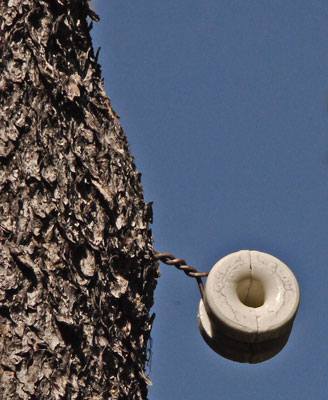
Nearly Round Insulator |
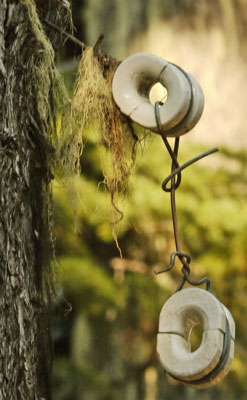
More Oval Insulators |
| Both photos were taken in Oregon in 2018. Over time, the hole in the insulators got more oval, like the right photo. The left insulator has an exceptionally short lead wire; the line probably pulled away from the tree but was nearly straight, even with the short lead. Note the bulge in the left tree: This tree had trouble healing over the staple and tie lead wire. The first, short lead in the right photo may have caused the line to zig zag at too sharp of an angle, or splicing shortened the line, requiring a longer lead. The wire twisting on the second lead is of poor workmanship. Galvanizing zinc is still coating all wires. | |
| Forest Phone Line Insulators | |
|---|---|
When labor was cheap, in the depression and CCC era, many lines and extensions were built. During and after WWII, there was a tendency to prune the system down to its most essential parts, as labor and money got tighter, and commercial phones and radios took over some functions.
1915 Telephone Construction and Maintenance on the National Forests
Per the 1915 manual, commercial telephone lines were to be used where available. But the need for lines to communicate with remote locations that would not be profitable for a telephone company to build and maintain existed, so many lines were maintained by the forest service.
Many extensions were made to ranches, etcetera, to inform and enlist help from people living in and near the forests. "Miners, settlers, logging foremen, and other persons needed in the fire plan of a Forest may be appointed per diem patrolmen and allowed telephone service free."
Poles were used where there were not trees to hold the wire off the ground. But most poles have long since rotted away. Usually I find insulators and wire attached to live trees.
| Properties of Double Galvanized Telegraph and Telephone Wire | |||||||||
|---|---|---|---|---|---|---|---|---|---|
| Number Birmingham Wire Guage | Diameter in Inches | Weight in Pounds per Mile | Put up in Bundles of Mile | Approximate Breaking Strength in Pounds | Average Resistance in Ohms at 68° F | ||||
| EBB | BB | Steel | EBB | BB | Steel | ||||
| 4 | .238 | 811 | 1⁄4 | 2,433 | 2,676 | 3,000 | 5.98 | 7.15 | 8.32 |
| 6 | .203 | 590 | 1⁄3 | 1,770 | 1,947 | 2,183 | 8.14 | 9.83 | 11.44 |
| 8 | .165 | 390 | 1⁄2 | 1,170 | 1,287 | 1,443 | 12.43 | 14.87 | 17.31 |
| 9 | .148 | 314 | 1⁄2 | 942 | 1,036 | 1,162 | 15.44 | 18.47 | 21.62 |
| 10 | .134 | 258 | 1⁄2 | 774 | 851 | 955 | 18.80 | 22.48 | 26.16 |
| 11 | .120 | 206 | 1⁄2 | 618 | 680 | 762 | 23.54 | 28.15 | 32.76 |
| 12 | .109 | 170 | 1⁄2 | 510 | 561 | 629 | 28.53 | 34.12 | 39.70 |
| 14 | .083 | 99 | 1⁄2 | 297 | 327 | 366 | 49.00 | 58.58 | 68.18 |
| Iron wire is divided into three grades: Extra-Best-Best, Best Best, and Steel. The Extra-Best-Best (E. B. B.) wire possesses the highest conductivity, but the lowest tensile strength. | |||||||||
There were other gauges / diameters of iron wire, and copper might be used on special circuits, but number 9 was the standard communication wire, and is usually what I find in the woods. Smaller wires hold the insulators to the trees. The Galvanizing, or zinc coating, is often long gone and replaced by a layer of rust. Note that 314 pounds per mile is a heavy load. The tools, hardware, and phones were also very heavy. It took tough guys and tougher horses to build and maintain these lines.
Note that there was only one wire running through the trees. These systems completed the circuit using a ground. To hook up a portable telephone, one might toss a rock weighted bare wire over the line through the trees, and connect the other wire to ground by a metal stake driven into wet earth or by putting the wire into a creek. If the wires were rusty, if the water was too pure to conduct electricity well, or if airborne static were present, a better connection might be needed to get a clear signal.
Permanent phones in lookouts and any other buildings would have well bonded connections. But the lines attracted and transmitted lightning strikes, so in thunder storms, the wires were disconnected and thrown out the window.
Quotes on Line Construction A large amount of slack should be provided. The exact amount will be determined by the conditions, topography, etc., but in general each span should be given about 4 feet. The aim is to provide enough slack so that several trees may fall across a few spans without breaking the main line. The wire should not be hung at a greater height than on a pole line, and in general should be about 15 to 18 feet above the ground. |
Limbs and bushes were trimmed 4' away from the lines. Since a trail usually ran right along the line, there was often a wide corridor cut to clear heavily loaded pack horses. The trails were well beaten in and maintained as people checked the line, and travelled its direct course between various forest facilities. Long after the lines were abandoned, the route is still often the best trail around.
The length of the wire attaching the insulator to the tree varied so that the active line was fairly straight.
The staples holding the insulators to the tree were installed so that they would pull out if too many trees fell on the line and stretched out all of the slack. Today, many of the staples are covered with wood and bark that has grown over them.
|
From the 1938 Handbook
Ideal Tree Line Location Good construction holds the wire as closely to the tree as possible and still does not allow either the line wire or the insulator to touch the tree. It is necessary that the amount of slack in the line be sufficient to allow it to come to the ground in any span when subjected to excessive loads such as fallen trees. The insulator tie should be made so that it will pull out of the staple when all of the slack in a given section of line has been taken up and the line wire will remain unbroken and continue to furnish some service though lying on the ground. This eliminates additional splices along the line on account of breakage. The material used for making ties should be such that it can readily be replaced in the staple or holder after being pulled loose.
Lines will be located: Adjacent to and in plain view from protection roads and trails. Short cuts along which the line will be totally obscured from view from a protection road or trail should be avoided as a rule. Savings in construction costs can sometimes be made by short-cutting across canyons, switchbacks, etc., but such savings must be very material indeed to justify placing the line out of sight of the road or trail. Along roads and trails so that the wire will not fall across the traveled way if hangers should break or if the line is borne down by the weight of snow or fallen timber. When the telephone line is at the outer bend of a stream, road or trail, a shield tree should be arranged for, where practicable, to prevent the line from swinging into the stream, road or trail, if it pulls off the tie tree. To avoid crossing main highways, roads, railroad tracks and power lines, if possible. Along the lower side of the railroad tracks, to keep wires from falling on tracks in case of breakage. To avoid the use of poles for tree circuits. It is a better plan to skirt a meadow or park by hanging the wire on bordering trees than to seek straight alignment and higher standards of visibility of the proposed line by building on poles across such openings. Likewise, rather than cross rock stretches which necessitate blasting for poles, or the construction of tripods, detour to trees if they are available. |
The insulators are split: The two halves can be placed around an already hanging wire. Another wire, often smaller, both wraps around the split insulator, holding it together, and runs a few inches to a couple of feet to a staple in a tree. The end of the wire at the staple is wrapped loosely enough that if a tree falls on the line and pulls very hard, the wire pulls away from the staple rather than breaking the communication line or pulling the staple out of the tree.
The number 9 communication wire mechanically runs freely through the holes in the insulator, and there is lots of slack, so that each span between insulators hangs down some, while still being well above the undergrowth. If a tree falls on the line, all the slack in several spans runs through the insulators, perhaps pulling the line all the way to the ground, but not breaking it. The line would then be electrically grounded, so someone would have to remove the tree, and redistribute the slack. In a few cases, like long spans, or downhill spans, the communication wire must be held from passing freely through the insulators.
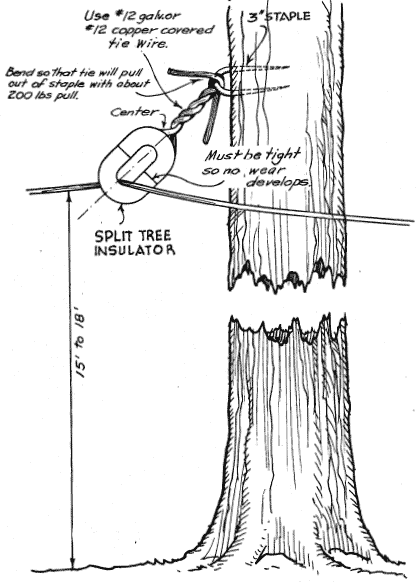
Standard Short Hanger [1938 Manual] |
|
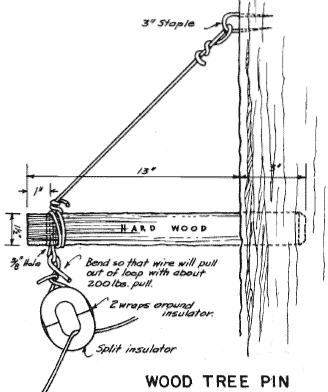
|




Assorted Tie Styles The lower two pull apart before breaking. |

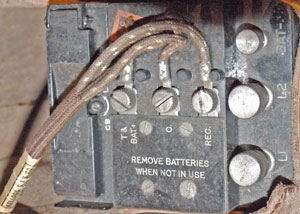 US Army EE8 Phone
US Army EE8 PhoneThis Army Signal Corps telephone was fully compatible with the forest service system, although the army typically connected it with a pair of wires rather than the forest service system with one wire and ground. |
This was the standard portable telephone used by the forest service. It weighed 19 pounds, and was 10¼" high by 10" wide by 5" deep. The heavy duty Eastern Birch case was coated with two layers of spar varnish. You turned the crank on the right to ring and pushed the switch on the handle to talk.
| |||||
I was lucky to find a snarl of wire in Oregon's Sky Lakes Wilderness in 2018 with these 3 splices.

Splice Crimp 9BWG 2 85J GROOVE J
3 Splices on Copper Wire near The Tipoff, Grand Canyon
|
Telephones, Pigeons, Mirrors, Airplanes, and Balloons
Dr. H. Barringer Cox, for example, worked out an early ground return line, or single-wire construction,
for Region 5's Santa Barbara (now Los Padres) National Forest in southern California. It was a practical and costly, if quieter, double-line metallic circuit. Ground return lines were also developed and used by the armed forces in this era.
This section contains some quotes and photos from my old notes on various hikes. Undoubtedly I have missed a few here, and I have seen but not commented on more artifacts. Many of the quotes refer to these systems as radio or rf systems. After the research I did to write this page, I think these phones were not modulated to radio frequency, but communicated at audio frequencies. I can't remember why I thought they were rf systems in the first place.
From: 2018_PCT_Sierra_City_Ashland.html Northern California
Wednesday, August 22nd, 2018
The first crossing of the Sisson Callahan Trail had a sign and good tread east and west of the PCT. There was also an old wood utility pole on the ground, with some hard steel wire, probably part of the ground loop RF telephone system of old.
From: 2018_PCT_Oregon.html
Friday, August 31st, 2018
North End of Sky Lakes Alternate Route
Along the Snow Lakes Trail I found a snarl of old ground loop telephone wire and took pictures of several splices. The wire was rusted, but it started out as hard galvanized steel wire about 3⁄16" diameter. Later, between Grass Lake an Seven Mile Trail, I took pictures of the old insulators in trees, some brown ceramic and some more common white ceramic. In one dead, barkless tree, I could see the wire had first been 10' off the ground, and later was moved to 15'. The number 5 had been carved in that tree several times. In that tree and some others, the scar caused by the wire could be seen. There also was a more recent diamond blaze with nails, which I eventually guessed was for the short, squat version of the Pacific Crest Trail System diamond blaze, as I continued to see them after the insulators disappeared. After 7 Mile Trail, the PCT treadway was of lower workmanship, so I figure the wire and the Oregon Skyline Trail continued down Seven Mile Creek.
Sunday, September 23rd, 2018
Sometimes You Hit the Jackpot
I hitched into Government Camp expecting nothing more than to buy groceries and head towards Timberline Lodge. But a town visitor center had a great little museum, with displays on skiing, the USFS, and art. The forest service section had several phones that used the type of lines and insulators I've photographed all over the USA. The receptionist was very nice, informative, and helpful. At one point, she asked whether I needed anything else. I said that I knew it was a strange request, but I'd like to go behind the ropes and photograph all the phones, because I still see so many lines in the woods. She said I could, but only if she could stand around and pepper me with questions. The deal was struck. After not too many questions, she suggested that who I really should talk with was the retired USFS guy who would be working starting at 2pm. After just a few more questions, she called him and he said he would walk right over.
He explained all about the phones, and then all about fire finders, lookout towers, and even a little about the CCC.
By 1915, there was a phone line up Mount Hood. Above treeline, 6,000', the number 9 galvanized steel wire just laid on the rocks, and that was sufficient insulation for a ground loop circuit. Sometimes they rolled up the wire for winter to keep wildlife and falling trees from breaking it. Along the line, a portable phone could hook in by tossing a bare wire over the line with a rock, and that contact was good enough for clear communication. They still used this type of phone into the 1980s at Bear Spring. Even later, perhaps even now, these phones connected all the buildings within a forest service compound, office, shops, fire, etcetera. He suggested the manuals might be available on eBay, but wasn't sure if PDFs might be available on the internet. He suggested that US Army Signal Corps manuals for the same devices might be pretty much the same. Manuals might have suggested certain types of splices for certain jobs, but old timers used whatever they had out in the field. A Union Pacific Knot was considered a good splice, but poor skills or insufficient wire forced some dubious knot splices.
A switchboard had chains of paperclips hanging from each bell as a visual indicator of which line was ringing. When I suggested that if the bells were of different diameters, you could hear the difference in the tones, he just rolled his eyes.
Handheld firefinders evolved into larger and larger units until they needed a building to house them, which was the origin of the fire lookout tower. Maps on firefinders weren't enough, so panoramic photos were developed so everyone knew what terrain was being discussed. The photos were in the towers and in every office in communication with the tower. All of this was developed under Osbourne on Mount Hood, and nearby.
The Clearwater Butte Lookout is still staffed today to watch the many campers near Timothy Lake.
He suggested I look for Marten traps, 3" triangular holes in trees, which might look like blazes. Martens, being curious, would stick their hands in and be caught. The traplines might be along old trails, utility lines, etcetera.
Sunday, September 30th, 2018
On the long ridge ascent, I could often see the old telephone insulators in trees, and see the old deep straight up trailbed, now covered in stick litter and replaced with switchbacks.
From: 2017_Mountains_to_Sea_Trail.html North Carolina
Thursday, May 11, 2017
Last night was quite clammy, and in the morning I found the clouds had descended around me. I had breakfast at the Mount Mitchell State Park Restaurant, the fourth viewful and rustic lodge of the trip (Cheaha SP, Tapoco Lodge, Pisgah Inn). The summit of Mount Mitchell, the highest point east of the Mississippi, had a nice tower and museum, annd great views. On descent, an Americorps crew was planning 7 weeks of work on the heavily used and eroded trail. Many thanks!! I found an iron radiotelephone wire with an insulator still in a standing, living tree. In the east, this is rare as most trees have been cut or died and fallen since radiotelephones went out of use. The iron wire had lain in the fork of a laurel long enough for the bark of the bush to have grown a tunnel for the wire to slide around in.
From: 2017_Sierra_Nevada.html California
Wednesday, September 6, 2017
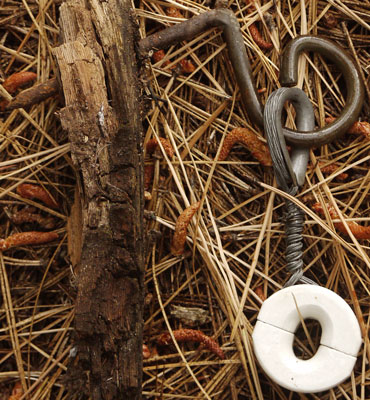
RadioTelephone Insulator South of Cedar Grove
The hook is properly known as a Telephone Tree Hook.
From: 2017_Pinhoti_Trail.html Alabama
Monday, March 20, 2017
I walked north from Trammel Trailhead. There were recent slash and control burns. I found a stand of old catface stumps, sawn above the sap collection scars, and old radio telephone steel wire, but no insulators in trees.
From: 2003_PCT_May.html Southern California
Friday, May 23, 2003
Approaching 3 Points, I saw a single strand of copper wire strung through the trees, and wondered if it was part of an abandoned ground loop rf telephone, which were used in some forests in the WWII era. I camped a half mile past Little Rock Creek Road.
From: 2013_PCT_Mexico_Kennedy_Meadows.html Southern California
Thursday, May 16, 2013
The PCT is closed from Eagles Roost to the Burkhart Trail due to the endangered Mountain Yellow Legged Frog. Therefore I detoured from Islip Saddle northeast on the South Fork Trail, then west on the Punchbowl Trail, then south on the Burkhart Trail. I met no other hikers on the reroute. Perhaps most other PCT hikers continued on the PCT to Eagles Roost, then walked Highway 2 to Buckhorn Campground, regaining the trail there. I saw a Kit Fox Vulpes macrotis on the South Fork Trail, where there were also poles, wires, and insulators from old ground loop radiotelephones.
From: 2014_Sierra_Nevada.html Central California
Saturday, September 13, 2014
We walked west to the South Fork Kern and Tunnel Meadows, exploring old corrals, fences, ranger huts, and weather and snowpack monitoring stations. We then summited Kern Peak, enjoying views of our intended route and the ruins of the lookout tower. There were old ground loop radio telephone lines along most of our route.
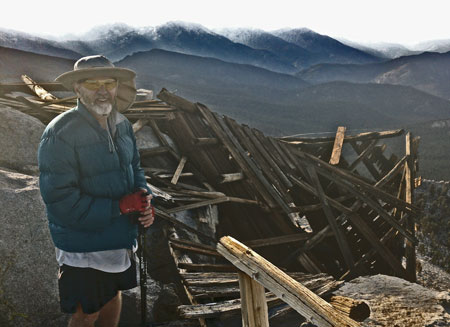
Tunnel Meadows Airfield History (36.38°N, 118.26°W)
A ~2000' airstrip was built in 1931. Soon after, then Col Hap Arnold crashed on takeoff probably due to high afternoon temperatures and the 9100' altitude. A pack station / resort often operated at the field through its history. The airfield was in use as late as 1985, but it closed when the wilderness was established. Military pilots still practice approaches (not touching down) to hone their high altitude, mountainous terrain skills. There are unique rocks in historic photos of the the strip, which I think I recognize from my hike. So I'm sure I could find and walk the old runway. Maybe some of the old camps and corrals Jim and I stopped at were part of the operation.
From my memory, Col Hap Arnold called for help on these phones.
Kendrick Mountain Wilderness Pumpkin Trail Telephone System
September 1, 2019
A volunteer working in the Kendrick Mountain Fire Tower said the tower had been built in 1964, and though he had been visiting it for decades, he had never seen or heard of any remnant of the old Forest Service Phone System in the tower. I walked down the ridge line, intermittently north of the Pumpkin Trail. ¼ mile east and west of the old cabin ruins (burnt in the Pumpkin Fire), old #9 iron wire is on the ground, with a couple of Western Union Type Splices, but I saw no crimp sleeves or tree insulator hardware. Smaller diameter iron wire with Western Union splicing is present near the cabin ruins.
I also saw no sign of the old phone system at the Apache Maid Tower yesterday.
From: 2016_AT_Vermont_Maine.html
Tuesday, June 14th, 2016
The Fire Warden Trail had an old garage with a snarl of old ground loop telephone wire, and there were a few old poles supported by large piles of rocks. The bedrock was shallow and often exposed: Therefore holes for the poles would not have worked.
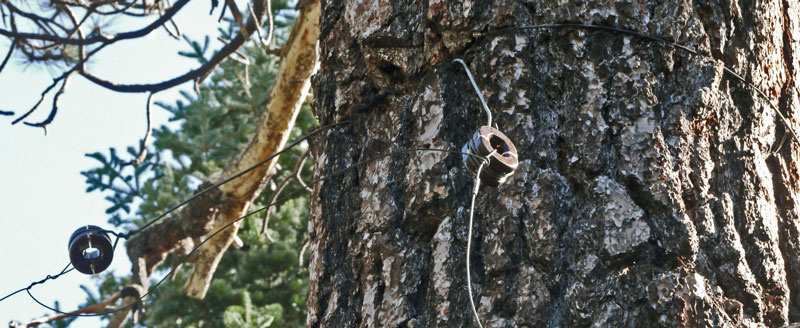
Blackrock 2 Insulators 2 Types of Insulators, Sloppy Workmanship, Girdles Tree |
August 16 - 18, 2019
I photographed the old wire in trees near the Blackrock Station. Across the road from the Visitor Center and a few hundred yards south / downhill, there is typical #9 wire, but then near the station there is probably copper coated iron wire about 5⁄64" diameter. In this smaller wire there are many breaks, so few if any spans still horizontal between trees, and many crimp sleeve splices on extant wire. The workmanship on these lines near the station is poorer than that out in the woods, so I suspect it was retrofit after the age when people really understood these systems, and how to work on them.
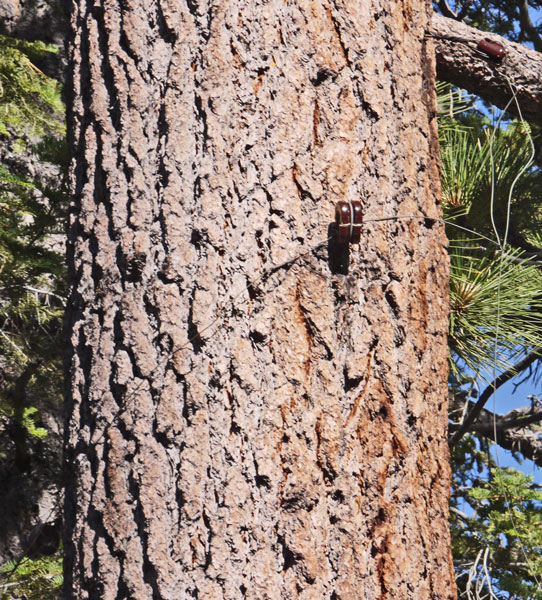
Blackrock 3 Insulators East of road. Egg type insulator (upper right) held wire in tension over the road. The split insulators (center and lower left) held the wire only an inch or two from the tree. |
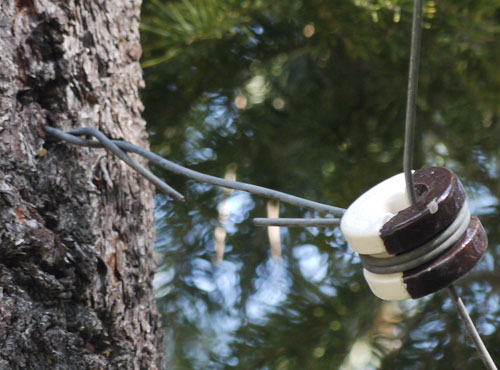
Blackrock Brown and White Insulator Halves, 9BWG Iron Wire |
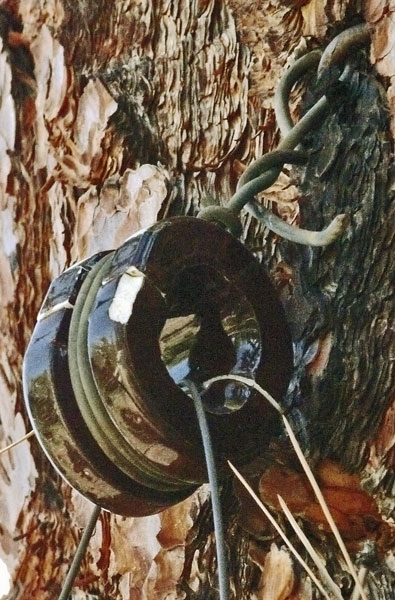
Blackrock Insulator, Iron-Copper Wire |
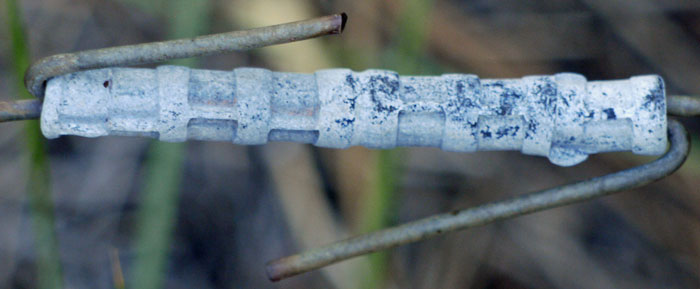
Blackrock Splice |

Blackrock Splice |
|
West Casa Vieja Cabin Ground
Note Fabric and rubber insulated wire. Text PATD probably means patented. Probably part of a phone in the cabin, but possibly installed for a radio or generator supplied power. There is also a plastic tube entering the cabin, suggesting there was once running water. |

|
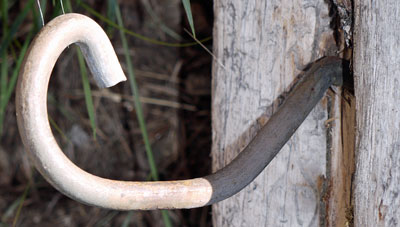
Casa Vieja Hook There were several of these installed at intervals of several feet along a downed log, suggesting that though these hooks are of a telephone type, they were probably installed for some other reason. |
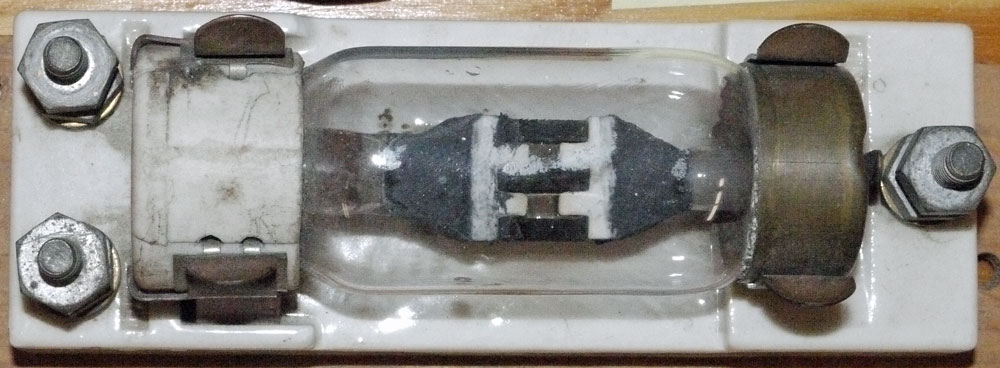
Fuse Relay |
|
Fuse Relay for U. S. Forest Service Fire Phone Line
Blackrock-Bald Mountain-Beach-Kernville There are marking on the glass tube, but I was not able to read them. The block is marked 'ground' at left, 'VAC-1.1 N. E. S. Co' in the center, and 'line' for each connection at the right. On display at the Sequoia NF Blackrock Visitor Center |
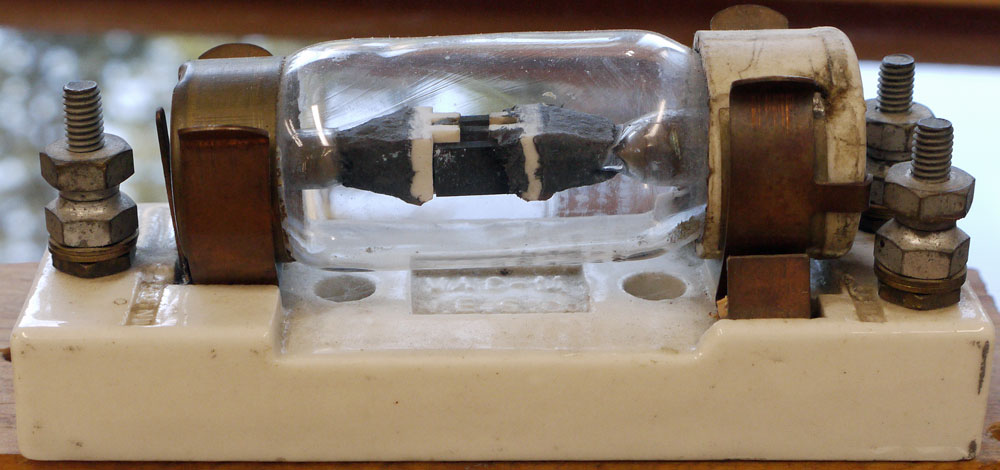
Fuse Relay |
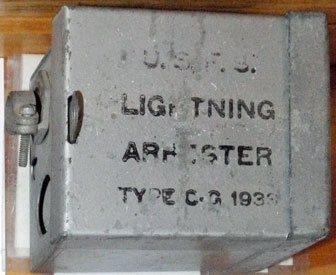
|
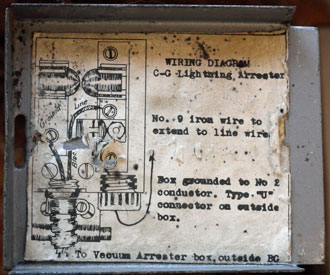
|
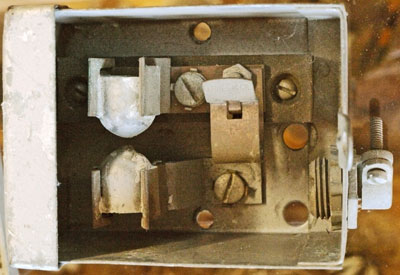
|
|
Lightning Arrester U. S. F. S. Lightning Arrester Type C-G 1933 On display at the Sequoia NF Blackrock Visitor Center | ||
August 18, 2019
I visited the Kern Valley Museum, Kern River Historical Society. They had an excellent display of old USFS phones and insulators assembled on a wall, as well as other old phones and insulators. A 1916 version of the Sequoia NF map showed the route of the lines, as well as other phone facilities. I have seen similar information on other old USFS maps. A research annex across the street may have more phone system artifacts and documents.
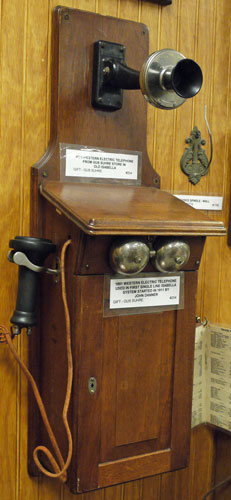
|
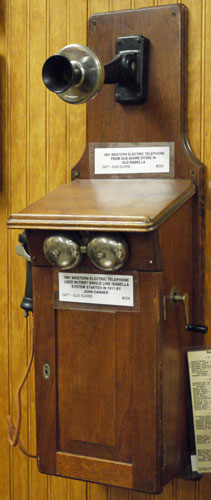
|
|
1891 Western Electric Long Wall Type Phone Used in first Single Line Isabella system started by John Danner. #254 | |
|
Army Surplus EE8 Phone
EE8 Notes |
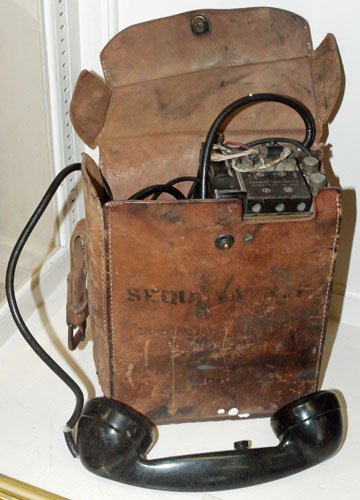
Army Surplus EE8 Phone |
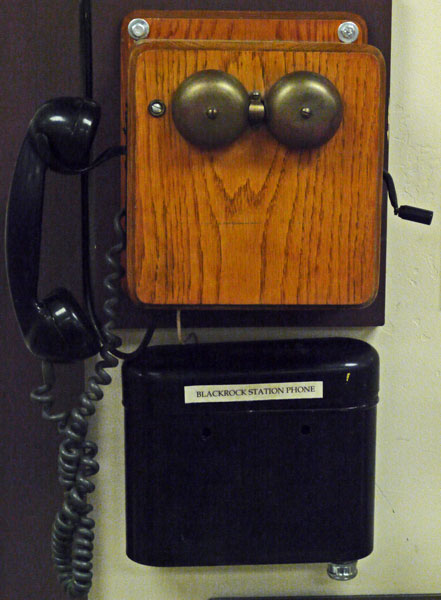
Short Wall Type Phone Over Blackrock Station Phone Black Metal Case |
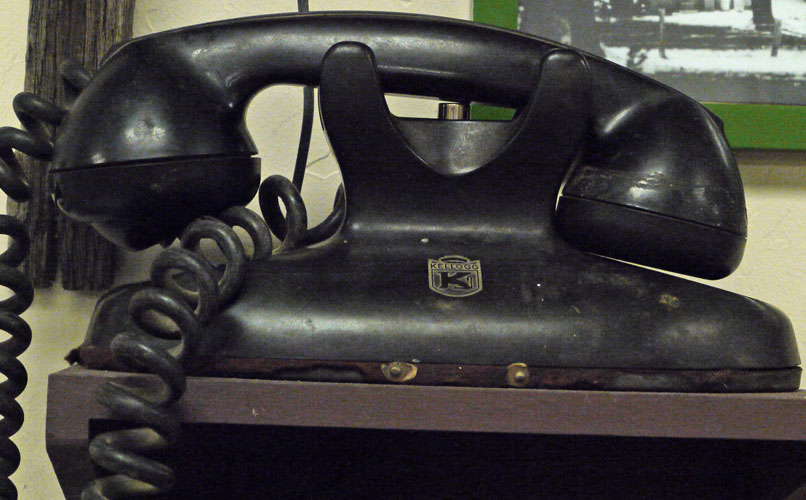
Kellogg Desk Cradle With Hand Set |
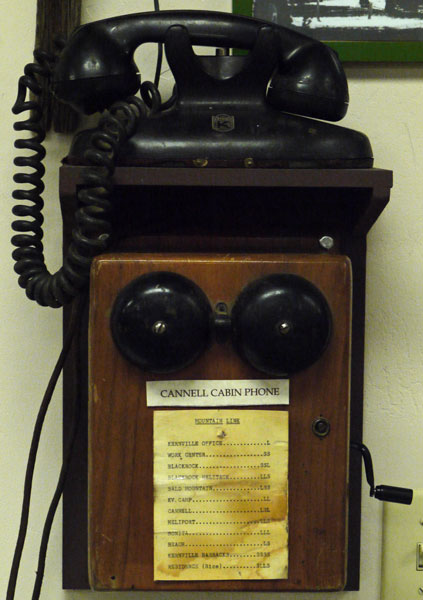
Cannell Cabin Phone Kellog Desk Cradle with Handset Over Generator and Bell Box |
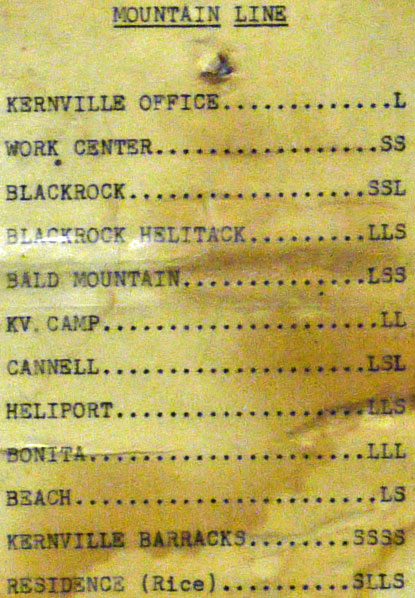
Cannell Cabin Phone Detail Long and Short Ring Sequence to Call Specific Phones Note Helicopters were in use when this list was made. |
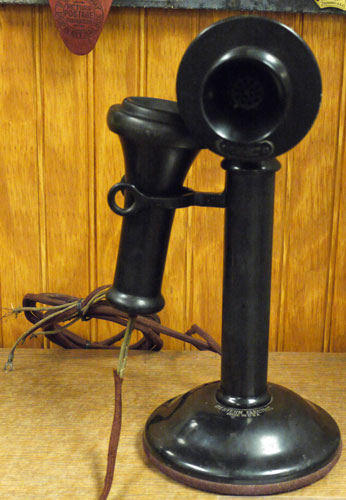
Western Electric Candlestick Desk Stand Phone |
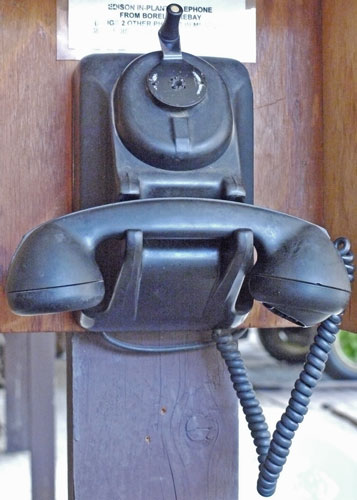
Phone From Edison Borel Forebay |
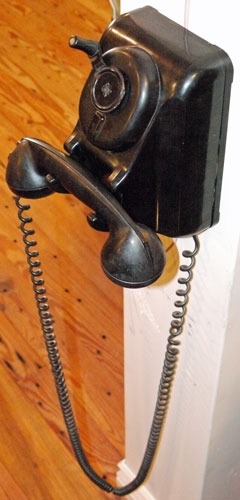
Phone From Edison |
| The museum had three of these hooked together at various places so visitors could call on them. These phones were used by Southern California Edison at their Hydroelectric Dams, but were probably interoperable with the phones in the Forest Service system. | |
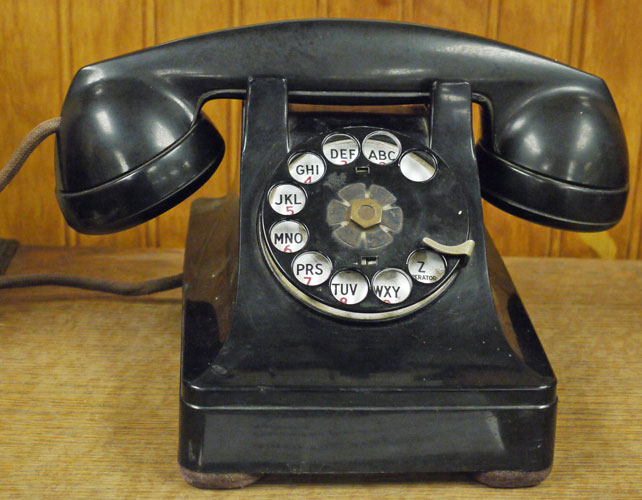
Rotary Dial Phone Note the newfangled dial. This phone is of later technology than the phone systems featured here. |
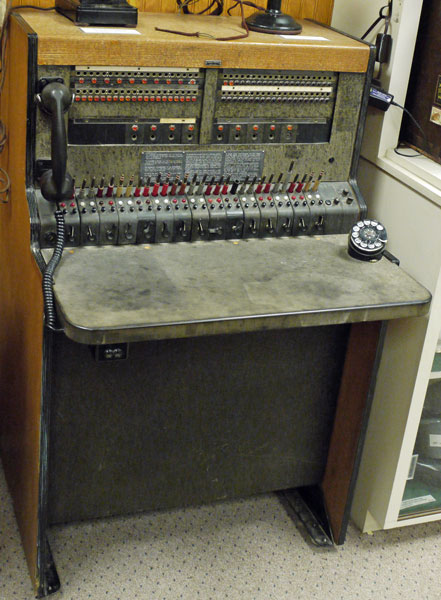
Switchboard with a Dial Too An intermediate technology, this switchboard allows the operator switched systems I discuss above to be connected to an automated rotary dial switched system, such as the Bell network. |

Cleat / Insulator |
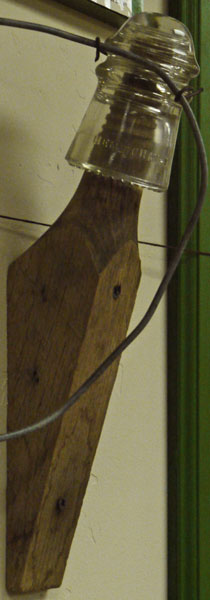
Cleat / Insulator |
| Cleats and insulators for pole mounted lines. The US Forest Service avoided poles and used tree mounted lines wherever possible. Many pole lines have rotted away, but I've found just a few. | |

Insulators and Crossarms Very typical in railroad signalling, telephone company, and power lines, not common for USFS. |
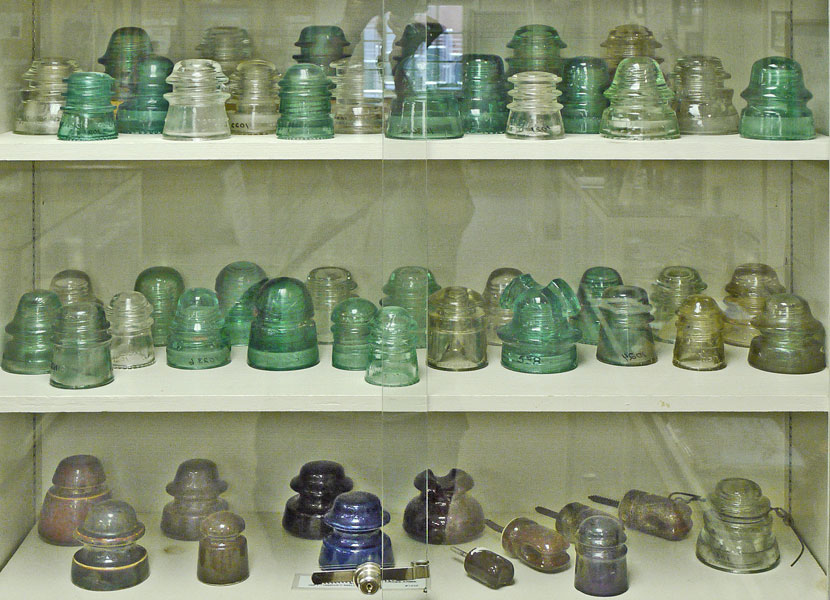
Many Types of Insulators |
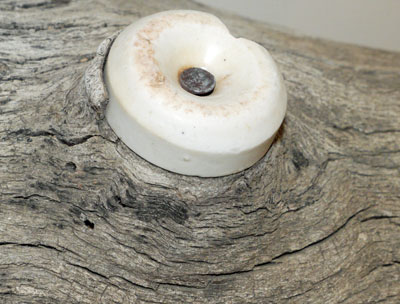
Ceramic Insulator in Oak Tree |
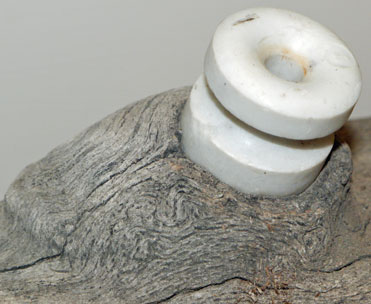
Ceramic Insulator in Oak Tree (Marked T) |

Ceramic Insulators in Oak Tree | |
|
These are not typical of forest service systems. Perhaps they were part of someone's private line. Museum Label: Phone Insulators on Black Oak, Davis Station Area, Greenhorn Mountains | |
| Notes From: United States Department of Agriculture Forest Service Lyle F. Watts, Chief TELEPHONE HANDBOOK April 1947 | ||||||||
|---|---|---|---|---|---|---|---|---|
|
48. Span Length, Long Spans Spans of 1000 feet or more are both good practice and economical for tree line construction under certain physical conditions and heavier construction is used. The following points are essential determining factors: (a) Use only across canyon or swales where there is sufficient ground clearance to allow for proper sag. See Sag table. (b) For supporting long-span use large trees, rock bluffs, or poles that are strong enough to carry the load that may be placed on the wires during sleet or ice storms. (c) Be sure the line is clear of any overhanging limbs or trees. (d) Use guage and kind of wire specified in long-span construction table page (e) For these long-spans, the strength of supports, dead-ends, fittings and anchorage should be adequate to withstand the maximum tensions that may occur on the line. 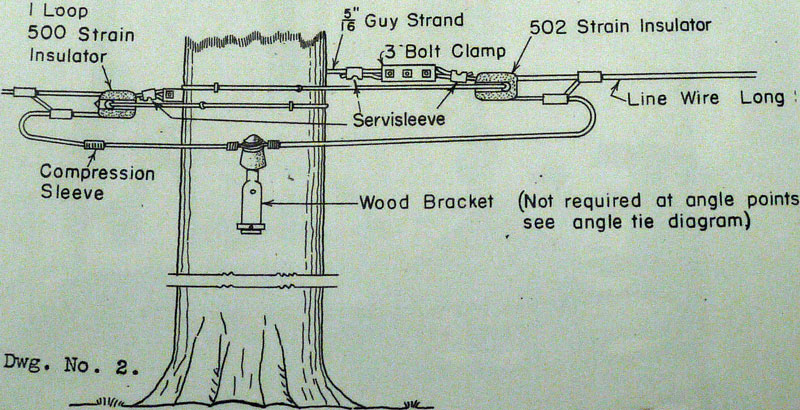
Long Span Tree Dead End | ||||||||
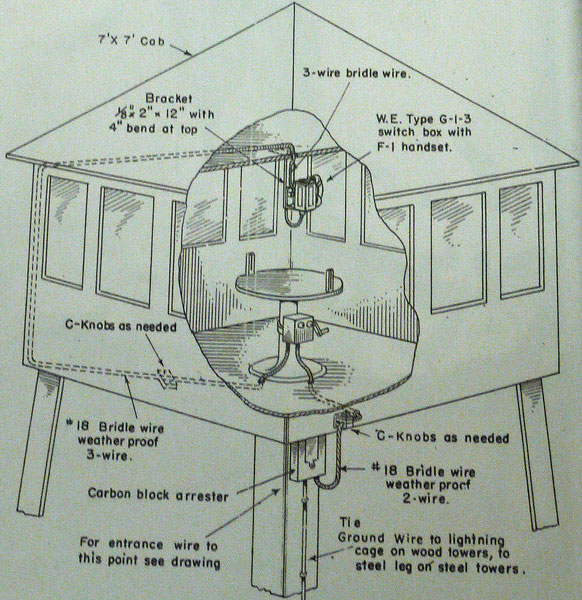
Telephone Installation - Tower Cab | ||||||||
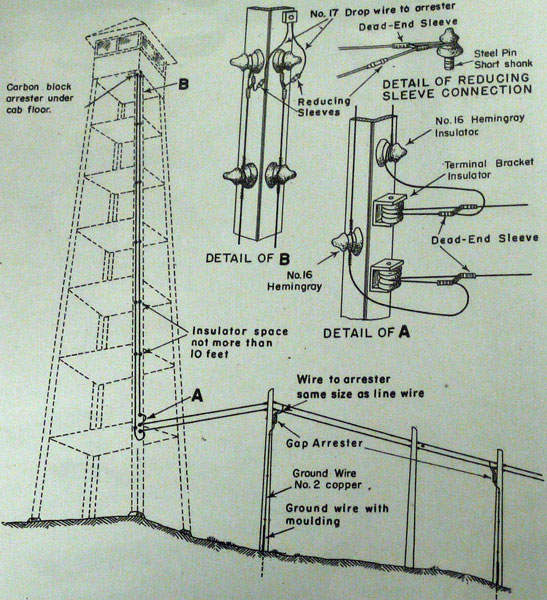
Single Circuit Entrance - Steel Tower | ||||||||
A telephone line leading to, or along a ridge, is subject to more lightning attraction than is a line located in a valley. Added protection should be given to a line located, especially to span, where they connect to the main line. Gap arresters should be used on the first poles or tie trees on each side of the connection. Where possible spur lines should be disconnected from the main line during periods of non-use.
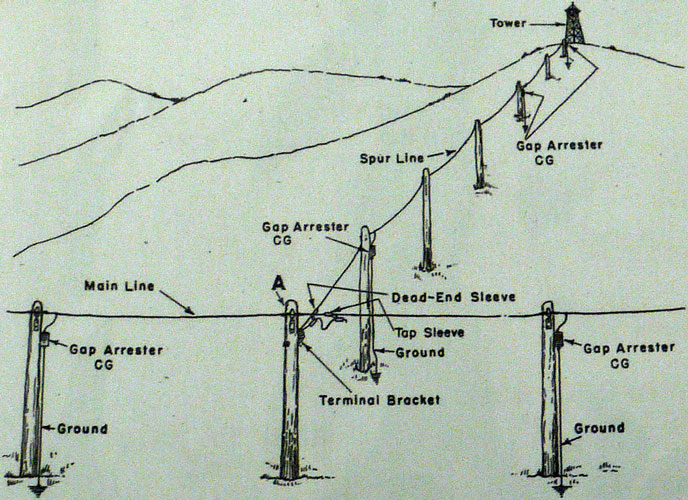
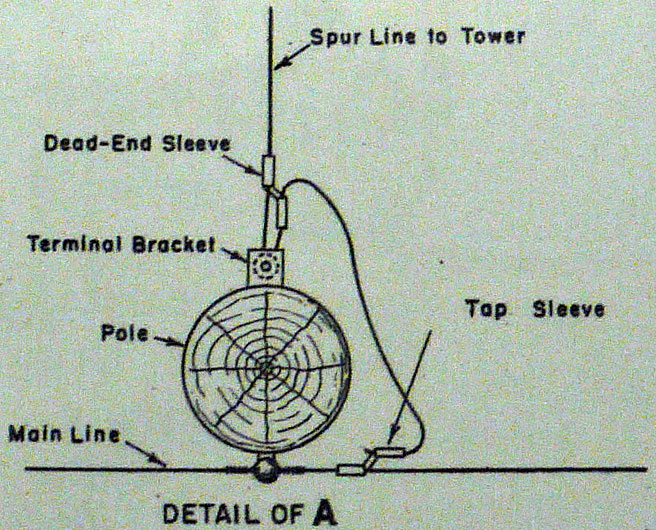
Lightning Protection For Spur Line Ground Circuit
| ||||||||
Telephone Instrument Types | ||||||||
Type B Lightning Arresters | ||||||||
| Notes from: Kernville Museum Phone Documents |
|---|
| From 1933 through 1941 the Isabella Ranger Station was occupied by the CCC. Camp DF-102, Company 6454, was first established in November 1933. From 1939 to 1941, the CCC completed 52 miles of telephone line and maintenance. |
|
Notes from: The Bakersfield Californian Monday May 8 1933 High Sierra Linked by New Telephones From Cannell Meadows, 20 mile northeast of Kernville via 100 miles of wire and 10 phone points Including Breckenridge and Greenhorn Forests and Piute Mountain to Kernville Lookout Station with exchanges at the Gus Shure Store in Isabella and the Mrs VM Lundberg store at Bodfish making outside connections possible with Forest Service lines All to be complete within 3 weeks |
|
Partial Qoute From: The Bakersfield Californian Wednesday January 1 1944 The were 650 miles of telephone line in the Sequoia National Forest. |
|
Sequoia National Forest Mountain Line The first telephone system on the Sequoia National Forest came into existence around 1912, serving as a lifeline to the outside world and remote Forest outposts. In situating these stations, the prime considerations were horse feed and a two hour ride to the next guard station. 1912: First hand cranked telephone systems installed on the Sequoia National Forest 1916: First map of the Sequoia National Forest which includes existing telephone lines and connections to guard stations and lookout towers. 1940: 700 miles of uninsulated metallic wire strung on trees from Pinehurst Station in Fresno County, to Lone Pine in Inyo County, to Porterville (California Hot Springs) in Tulare County, through the cow camps on the Kern Plateau, to Gwynne Gold Mine in the Piute Mountains, to Havilah Ranger Station in Kern County. 1978-80s: The only remaining parts of the old telephone system are the hand cranked phones from Bald Mountain Lookout to Blackrock Ranger Station on the Kern Plateau. The call sign was "Blackrock, Bald Mountain; pick up the mountain line." |
|
Telephone Communications By 1926, the forest telephone system had become the largest in the three county areas, with 535 miles of line. Then in the late 1930s, short wave radio began relaying messages. After World War II, when communications technician Albert Beard returned to the Sequoia National Forest, he was welcomed back by his former coworkers and his father, veteran ranger Robert Beard. But it was a different national forest from the one he had left four years earlier. In those early day years, Al Beard helped maintain the forest's telephone system, a 700 mile system that stretched from Pinehurst to Havilah. But the war had taken its toll in terms of shortages of equipment and vehicles, imposed as a result of war time diversions. There were all kinds of shortages, including repeaters and relays. That was my responsibility, to maintain these old 'metalic' lines... the telephone system that kept the Sequoia together. It was the first telephone system in the mountains. "It required a lot of walking and riding to maintain that line," Beard said. (Giant Among the Forests, Author Gene Rose). By the early 1940s the first short wave radios came onto the forest; but the old hand cranked phones did not disappear until the mid 1950s. |
|
Notes from: |
|
Notes from: In 1906, the first USFS phone line nationwide was built in Wyoming. Flathead NF's first line was built in 1908 from Kalispell to Koram, expanding in 1910 to Spotted Bear, and in 1912 to Big Prairie. In 1910, a line was built from Swan Lake to Spring Slide Mountain, and extended up Swan Valley in 1912. The Swan River line was planned but not built for 1906. In 1911, in neaby Glacier NP, there were 42½ miles of line and 9 phones. The Middle Fork Line was built in 1913 and 14. Soon, 5 lines terminated at Spotted Bear Ranger Station, Swan Lake, Kalispell via Coram, Big Prairie, Three Forks, and the Spotted Bear Lookout. By 1939, Flathead NF had 1,675 miles of lines. A 1956 report on Big Prairie Ranger District discussed newly constructed phone lines, and the unreliability of radios. 39 miles of backcountry phone line are still in use in the Bob Marshal Wilderness along the South Fork of the Flathead River, from Black Bear cabin to Danaher cabin, perhaps the longest working piece in the USA.
Equipment The USFS first used a fine insulated wire, but it broke easily, and the #9 iron wire replaced it. There was also WWI surplus "Outpost Wire" of steel and copper that could be tossed over bushes and limbs as the only insulation. Temporary fire camps might be connected in this way, with a mine phone or wooden phone box on a post in the camp. An Army surplus bayonet made a pretty good portable ground. But dry soil at some lookouts meant a wire had to be strung downhill to near a stream to get a good ground. The phones needed new batteries about once a season. The phone lines might still work with a tree on them, even under snow. On the Middle Fork was 7 miles of line through a twice burned and slide prone area. Lines required repair regularly. In 1936, a better line system was built, with guyed poles and 500' spans 30-50' above the ground over the worst slides. Solid white insulators were used until the late 1920s, but the wire had to be cut to replace them, and the splices would not slide through the insulators. In the 1940s, nicopress splices came into use. Two wire metallic circuits were occasionally built and had better sound quality, but required better skilled maintainers. |
Although this Grand Canyon National Park CCC system has very different construction details, it is of the same era and would use similar phones to the USFS systems, making it an interesting comparison.
From: Saturday, March 30, 2019
Grand Canyon National Park
I hiked north down the South Kaibab Trail to The Tipoff, west on the Tonto Trail to Indian Garden, and south up the Bright Angel Trail. There were CCC era pipe telephone poles at The Tipoff and paralleling the Bright Angel Trail. Modern water and electric also generally follow the Bright Angel Trail.
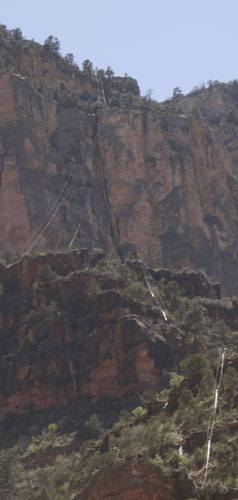
Phone Lines over Bright Angel Canyon
From Plaques in Grand Canyon Village |
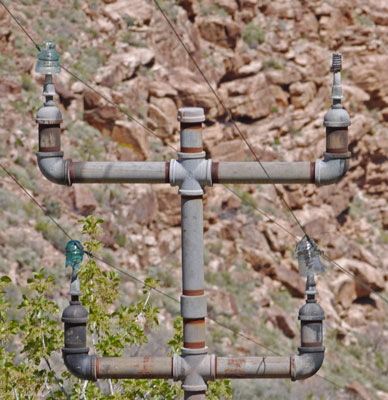
Bright Angel Telephone Pole at Tonto Trail Note 3 Different Insulators and Bend in Lines |
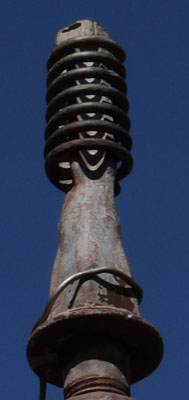
Insulator Threads are a Spring |
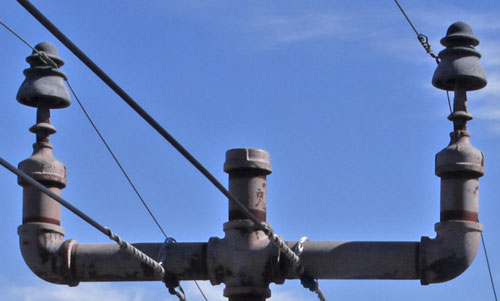
Phone Line at The Tipoff Note later lines attached to crossarms. One circuit versus two above. Attached to emergency phone along trail. |
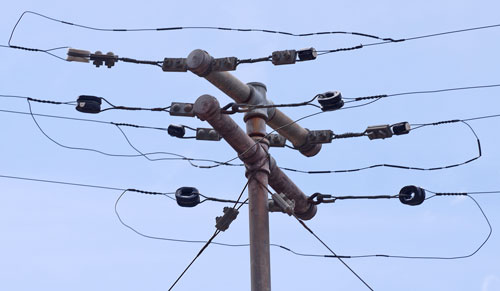
Bright Angel Phone Pole Anchors keep wire from sliding past this pole. May 6, 2019 |
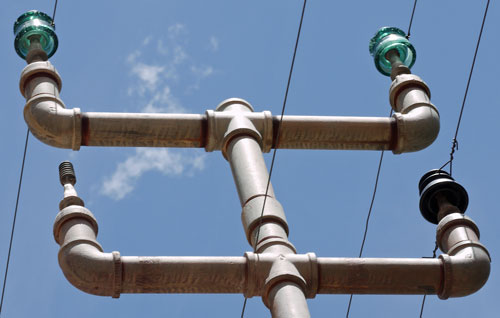
Bright Angel Phone Pole May 6, 2019 |
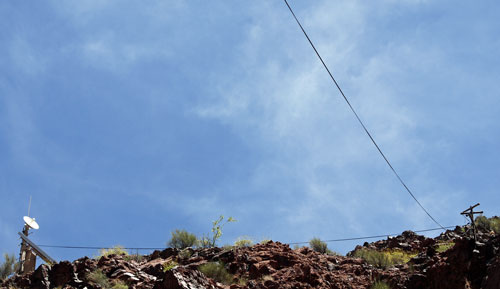
Bright Angel Phone Line Lower Shelter. Feeds an emergency phone with phone booth like reciever. May 6, 2019 |
Monday, June 3, 2019
Grand Canyon National Park South Rim
I walked down the South Kaibab Trail and continued west on the River Trail, yoyoing across the Bright Angel Bridge for water, and ascending the Bright Angel Trail except that I followed the old CCC phone line route where my map suggested it as an alternative. The old trail was still in pretty good shape, not badly overgrown, and mostly easy to follow and walk. In this very popular area, it was nice to have a little side canyon to myself for a while. Near The Tipoff and on this old route, I took some pictures of splices and insulators on the CCC phone system. This Grand Canyon CCC phone system differs from more typical USFS phones in carrying pairs of copper wires on glass or rubber screw on insulators mounted on galvenized pipe poles, so every aspect of field artifacts is different than the USFS systems. The phones and switchboards may have been identical, though.
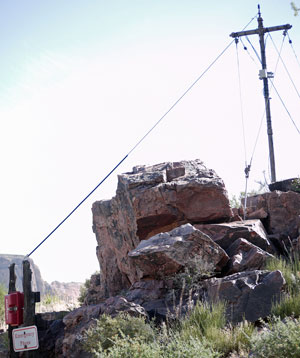
Emergency Phone at The Tipoff |
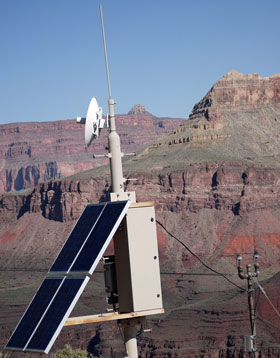
Radio Telephone at The Tipoff |
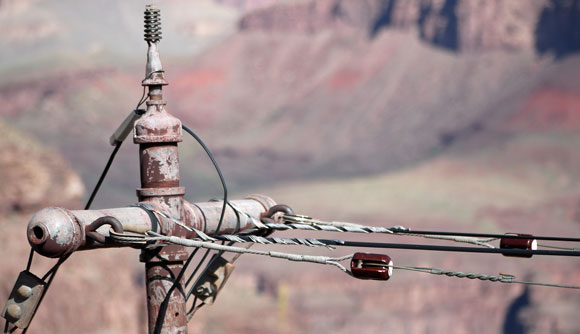
Insulated Wires Carry Emergency Phone Signal Old Wire Not Hooked In - The Tipoff | |
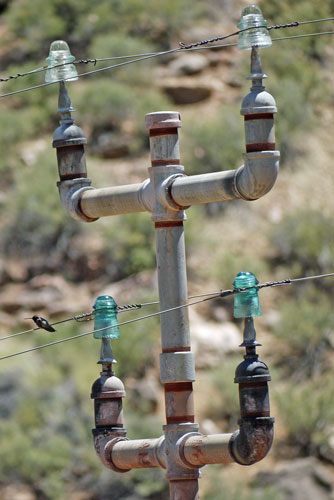
Different Insulators and Arm Lengths Above Versus Below - Is the Top a Later Addition? The hummingbird refused to comment. |
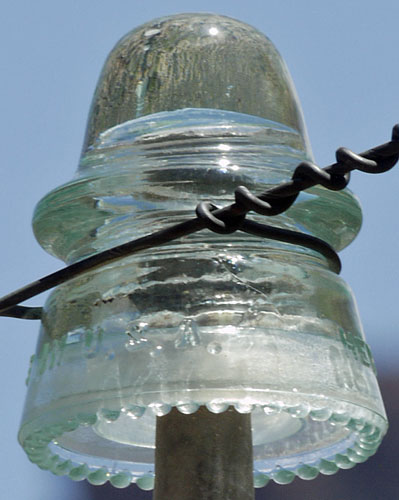
Clear Glass Insulator - Bright Angel CCC Phone Line |
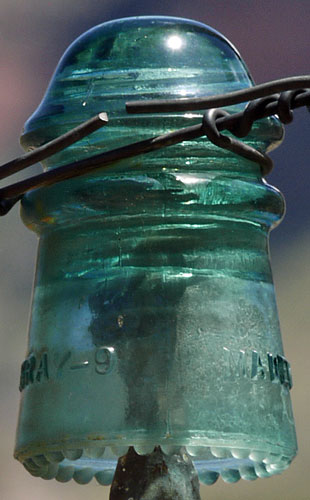
Green Glass Insulator - Bright Angel |
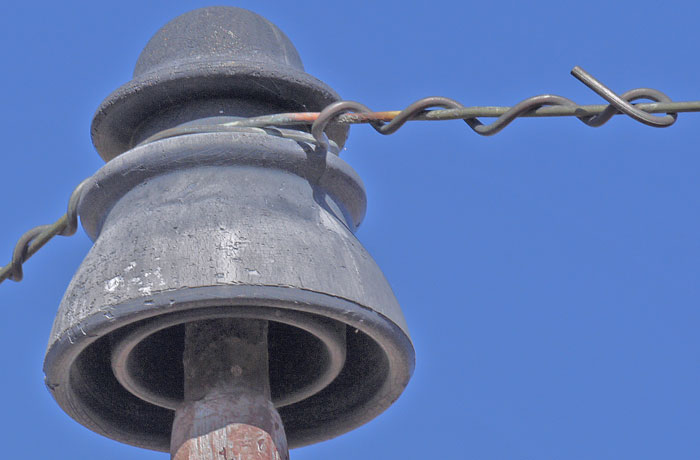
Plastic Insulator with Crazing, Spalling, Oxidation, Weathering - Near Tipoff |
|
Quoted From NPS Brochure: Because communication between the North and South Rims was frequently difficult and unreliable, the CCC began construction of a telephone line across the canyon in November 1934. A group started from each side of the canyon, stringing telephone line on metal poles down steep cliffs and over narrow gullies. Not only was the terrain rugged, but also inner canyon temperatures in the summer frequently exceeded 100°F (40°C)! When completed in September 1935, the line stretched from the North Rim along the North Kaibab Trail to Cottonwood Camp and Phantom Ranch. From Phantom Ranch the line crossed the Colorado River to a spur line on the South Kaibab Trail at the Tipoff. The main line continued along the Bright Angel Trail connecting Phantom Ranch to Indian Garden, the resthouses, and the South Rim developed area. The line was used so extensively for administrative purposes and rescues that another circuit was added in 1938-39. The Transcanyon Telephone Line has been used frequently to aid hikers, mule riders, and river rafters. When completed, the line was 25 miles long, later reduced to 18, with a total of 592 metal poles. Although microwave transmissions, satellite phones, and radios have replaced line transmissions (cell phones do not work within the canyon), small portions of the original line are still used today. |
The following two pictures were taken along the Boundary Line Road, south and west of Grand Canyon Village.
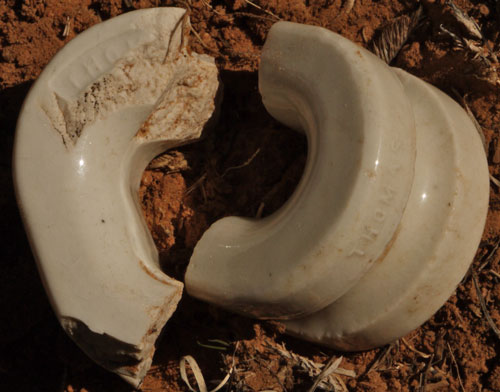
White Thomas Insulators The left insulator is not split and would have to be threaded onto the wire - old. The right, split design can be placed around already strung wire. Kaibab Plateau. I saw no wire or insulators in trees. |
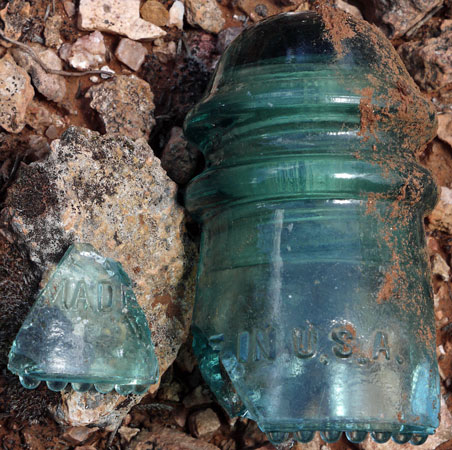
Green Glass Insulator Boundary Line Road |
| I found broken bits of these green glass insulators, which would be used on poles, along the Boundary Road - This is by far the most complete one. Curiously, I also found No 9 wire and broken white ceramic ring type insulator bits along the same road. Maybe poles were used after a severe fire downed the tree lines, or poles were used in immature forests or meadows? |
Because I am interested in US Forest Service phone lines from the early 1900s through the post WWII era, I explored this Bell System line of 8 poles, one dating to 1930 and another to 1956. The construction details are quite different, and provide an interesting case for comparison. An old lady walking her dog said she was a long time local, and the line had been there for decades.
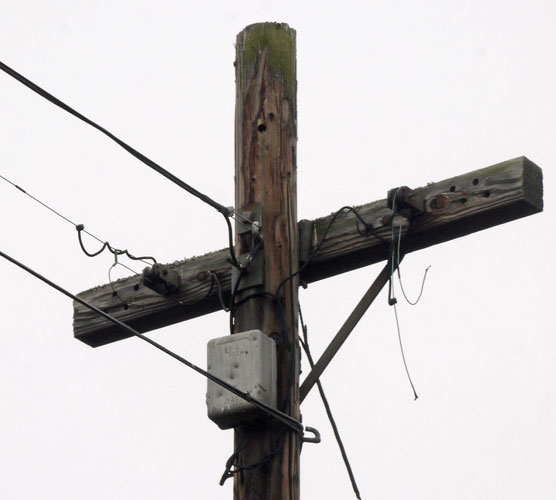
|
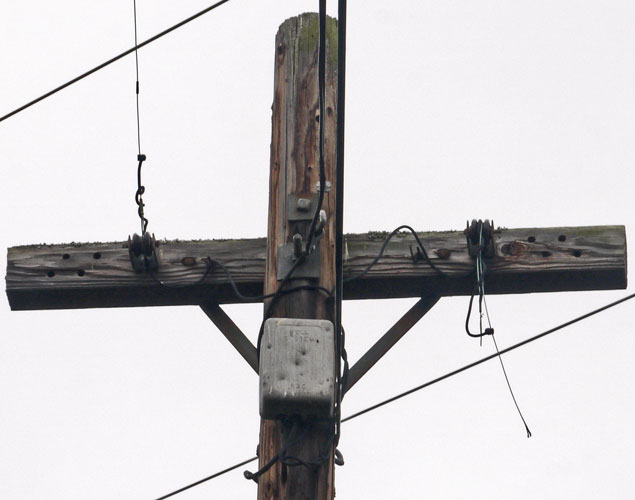
|
|
Above and below are 5 pictures of the most southwest pole, which I'll number 1. I did not find a date nail on #1. I am most interested in the two copper coated iron wires that run on glass or ceramic insulators, the highest on the various poles. They start here anchored on spool type brown glazed ceramic insulators. The tension is taken on zig zag shaped crimp sleeves, which seems like poor practice. Perhaps the line once went further and was shortened here after skills and parts for this type of phone line were more rare, and perhaps when the housing developments to the south were built. Wire ends seem squashed into spade type connections, but no longer used. Polymer insulated wires are attached with screw splices. A drawn sheet metal box is marked Bell System 83C, and is pocked with bullet or bb dings. Note the copper coated iron wire is spliced with sleeves many places. The Galvanic series says that copper in contact with iron will cause the iron to corrode first. There are also two rubber coated cables carrying perhaps a dozen twisted pairs of small diameter copper wire. In the air, a tension carrying wire is molded with the outer cable casing, but not underground. The splice box is shown below and left. Ends of yellow insulated wires protrude, I estimate 22AWG solid copper. A similar splice box is on pole 5; perhaps there are more. Older, perhaps abandoned wires or cables are present along the pole above this box. |
||
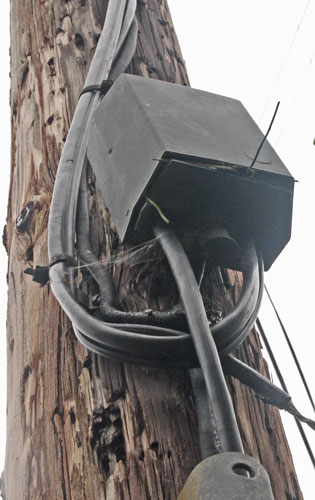
|
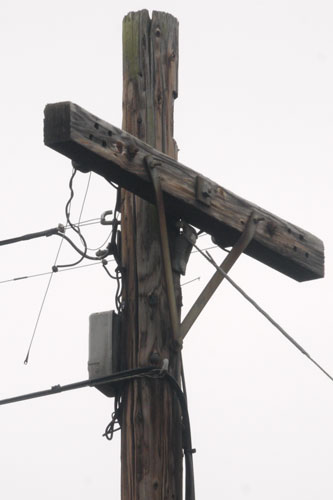
|
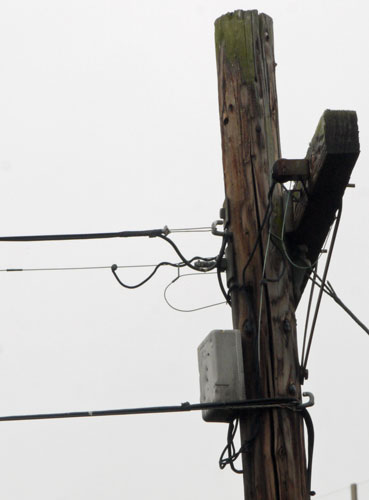
|
|
Corrosion and the Galvanic Series See too that copper has a lower potential than iron. For the purposes of this page, that means that if you have a copper coated iron wire, and you scratch through the copper coating, the copper will cause the iron to corrode away in a pit under the scratch. Such a pit may rapidly grow all the way through the iron core. Since the iron provides the strength of the wire, the pit causes the wire to break. Even so, the phone companies liked to use copper coated iron wire because alternating currents travel mostly on the outside skin of wires. A cheap and strong iron core surrounded by a much more conductive copper skin works well with proper treatment. But sloppy workmanship, such as pinching through the copper coating with pliers, will cause early failures of this type of wire. |
| ||||||||||||||||||||||||||
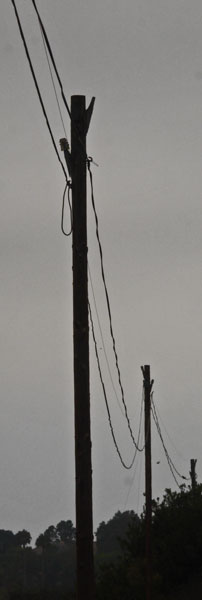
|
Two views of poles 2, 3, and 4, left to right. I did not beat through the brush to examine these poles close up, but they seem similat to 5 and 6, which were much closer to the trail. Note the excessive sag of one wire due to the missing insulator. |
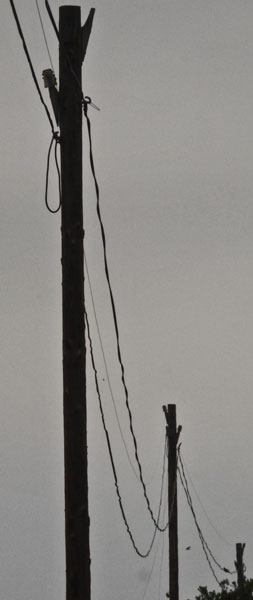
|
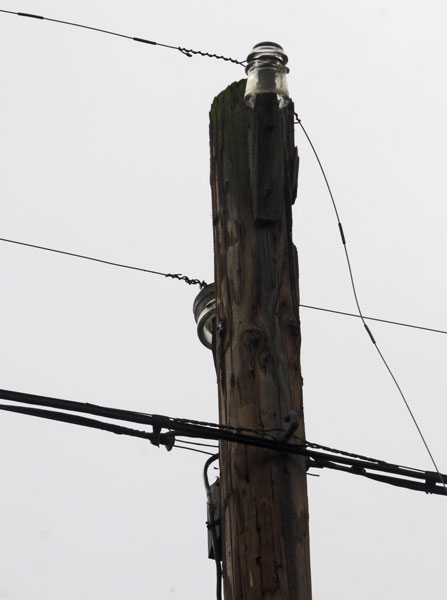
|
|
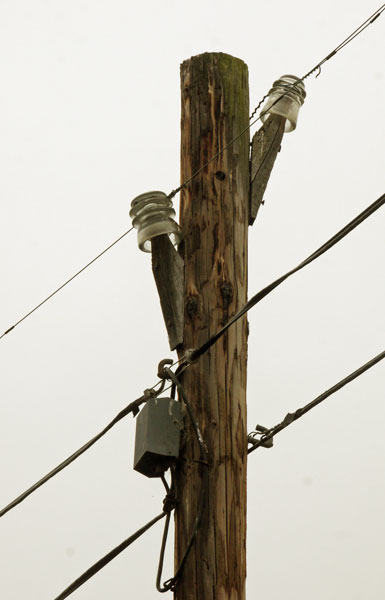
| ||
|
Pole 5 Note two types of insulators, and different wrapping styles. Note insulator cleat pulling away from pole. The pole date nail indicates 1954. The wire is bent. Perhaps it was on the ground and someone bent it repeatedly to break it and get it out of the way. Note the iron and copper wire oxidation colors. |
||||
|
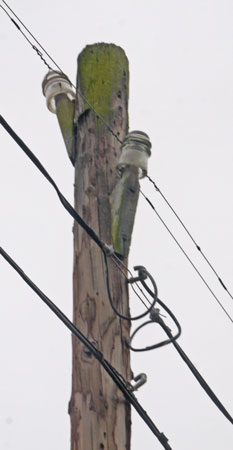
| ||||
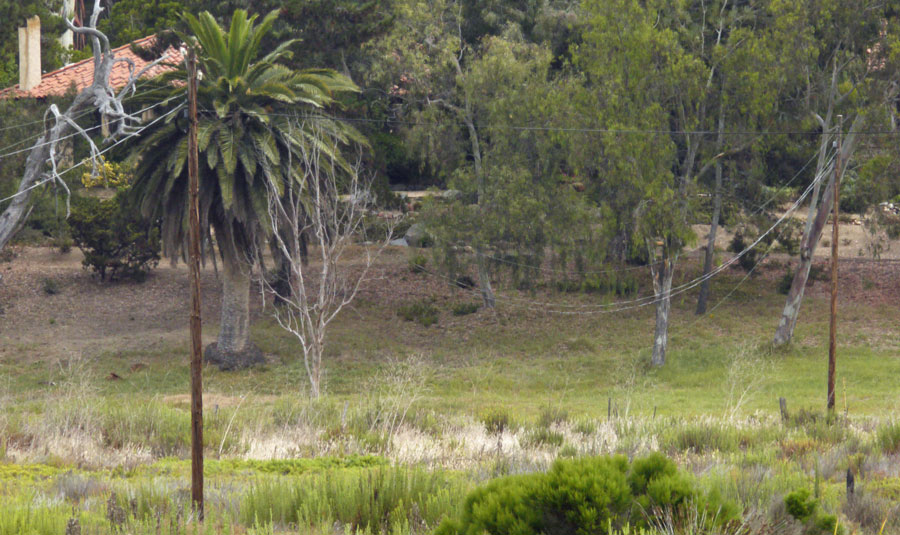
Poles 7, 8, Left to Right |
From: 2017_Mid_State_Trail.html Pennsylvania
Tuesday, June 20, 2017

Insulator

Insulator
From: 2016_GDMBR_Colorado.html
Thursday, September 8, 2016
On this surprisingly wildlife free day, I saw one Bluebird, one Magpie, a couple of nondescript little brown birds, a couple of ground squirrels, and cattle. An old telephone line on peeled but not lathe cut poles and with insulators screwed to wooden brackets was clearly abandoned, with poles down and insulators taken, but was fairly recently hooked to a reasonably modern telephone junction box. In some places, the poles were not held up in augured holes but by rock filled baskets made of sawed poles with insulator brackets.
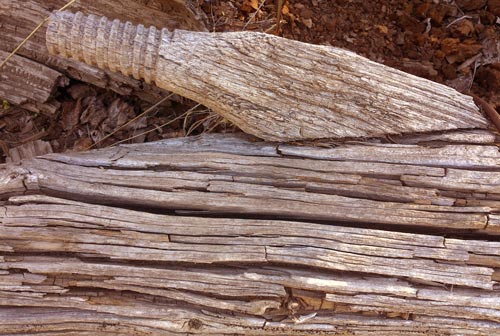
Old Telephone Pole and Insulator Screw Mount

Steel Insulator Mount
From: Tuesday, April 16, 2019
Petrified Forest National Park
Old US66 crosses the park just north of I40. The bentonite clay soil in the area does not permanently compact, so the roadbed was soft and supporting plant life as well as the surrounding desert. The roadbed berm, litter, and an old telephone line still mark its path, though. The telephone wires were gone, but most of the poles were standing.
Miles: 6 15
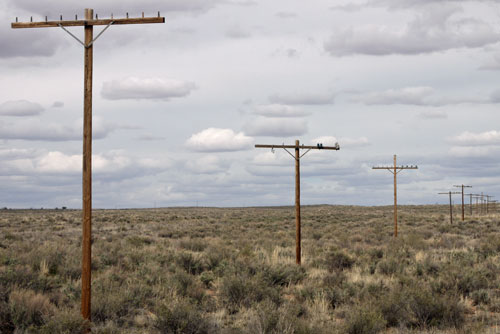
US66 Telephone Pole Line I saw these old style telco voice frequency unmodulated unmultiplexed pole lines in three places on this trip. |

Telephone Insulators |
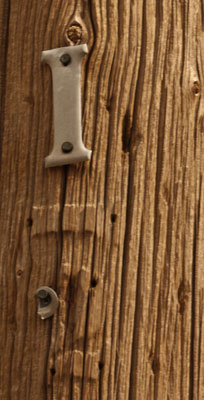
Pole Eroded Around Aluminum Numbers |

Communications Cable and Bits of Lead and Steel Lining |
From: 2016_Tuscarora.html
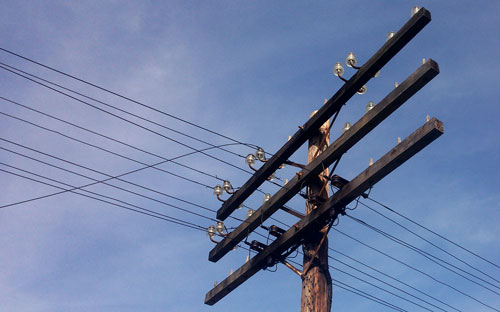
Old Railroad Signal Wires - C&O Canal